Changes in fashion of Keio University students and the school uniform
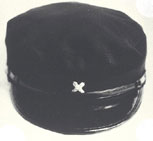
In the early Meiji period, students casually wore a kimono, and as the academic system developed, a rule was made in which honka(University) students should wear western clothes and yoka(University Preparatory School) students should wear the school uniform. However, in the early Taisho period, casual kimono style became popular again, and eventually settled with the Keio style; combination of round cap and low stand collar uniform. Looking at prewar fashion of Keio University students in monochrome photographs, they seem to express the spirit of the time, and we can see that they were fashion-conscious.
Merchant-like casual kimono style of the early Meiji period may be an influence of Yukichi Fukuzawa's principle of democracy
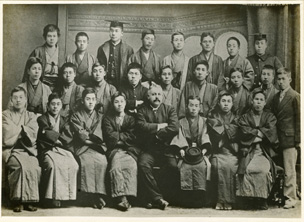
Today, in each campus of Keio University, students come and go wearing various clothes in various colors. What did Keio students of the early Meiji period wear to come to study?
Western clothes or a school uniform? Actually, most students casually wore a kimono with a kaku-obi(men's sash) without wearing a hakama. The merchant-look style seems to reflect Yukichi Fukuzawa's principle of democracy.
Later on in 1885, there was a time when western clothes suddenly became popular among Keio students. It is mentioned in the newspaper of the time that Keio students began wearing western clothes and cap that were tailored together. Their spontaneous action led to westernization of their outfits.
15 years later in 1900, the following dress code was announced by Keio University for Keio students. It stated that "Futsubu(based on the academic system at the time, this is a preparatory course to attend before going to university)
Students must wear the school uniform and cap when coming to school. University students must wear western clothes and a cap bearing the school insignia."
At the time, it seems that many students still wore a kimono, but a number of students seem to have been around in inappropriate style, wearing a kimono casually without haori(coat) or hakama(skirt), or wearing a square cap with a casual kimono. This was a time when students started to take on autonomous action, and such inappropriate clothing bothered some students. The dress code was made under a desire to demand discipline form students.
After this announcement, the stand collar uniform took root in Futsubu. On the other hand, university students were to wear western clothes, and it seems that they did not have to wear the school uniform.
A unique "tailor shop" and "round cap" that started in Futsubu
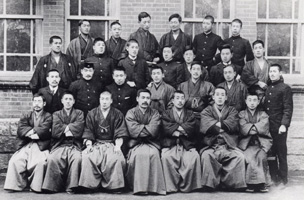
More students are wearing the school uniform, and those wearing a kimono are also wearing a hakama, maybe because this is a graduation photo.
By the way, there is a record that a "tailor shop" was established at Keio University in August of 1872, in the midst of cultural enlightenment. Yukichi Fukuzawa was the one who made the investment. He imported two sewing machines from the U.S., and the shop was revolutionary as it would mainly tailor western clothes but would also make kimonos, and as it also covered laundry and washing of kimono pieces.
The advertisement of this shop says that "it is more than clear that western clothes are useful. However..." and criticizes that western clothes are too expensive, and that "the western clothes made by our tailor shop are for everyday use of the average people." It declares to aim at popularizing western clothes.
This is followed by "the purpose of opening a tailor shop", pointing out that although women who live in farming villages are busy working in their farms, women who live
in the city do not have a job and have no choice but "to rely on men for food and clothing". It explains that the purpose of the shop is to create a career opportunity
for women at least within Keio University to ensure an income and improvement of the status of women. We can say that this business was very Fukuzawa-like, as it reflects his
principle of "Independence and Self-respect".
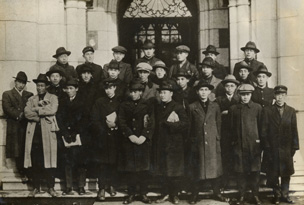
Most students are wearing the school uniform. Some students wear a felt hat or hunting cap, rather than the round cap.
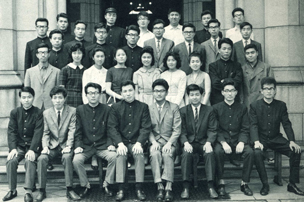
More students wear a suit, and among those wearing the school uniform, most of them wear gray trousers rather than black.
In October, 2 months after opening, Fukuzawa, who took initiative in launching the shop, hands over the business to Yuteki Hayashi, an old student. After that, the shop continued its business as "Maruya Sewing Shop". Although it was for a short period of time, a unique tailor shop existed at Mita Campus as a result of cooperation between Yukichi Fukuzawa who invested in the business and his student who took over Fukuzawa's will.
In the Taisho period, more honka students started to wear a kimono despite the dress code that stated honka students should wear western clothes. Therefore,
from around 1918, actions were made to standardize their outfit to the stand collar uniform and square cap. However, the square cap looked too grandiose and was unpopular among Keio students, and instead, the unique round cap with straight visor and wavy top (as in photo at the top of the page) became popular, and this style took root. It is said that Futsubu students started to wear this round cap.
Also from around the end of Taisho period, students started to wear the school uniform with a low stand collar (of which collar height was about 3cm), and a while later, the Keio style was established, which was the combination of "round cap and low stand collar uniform". Also, it became a style for Keio students not to bear a pin on the collar to distinguish faculties or school year level. Later on, in 1940, Keio University clearly stated the details of the school uniform and cap for the first time. We can feel the spirit of "Independence and Self-respect" of Keio University from the fact that Keio students spontaneously established their own style which became official afterwards.
